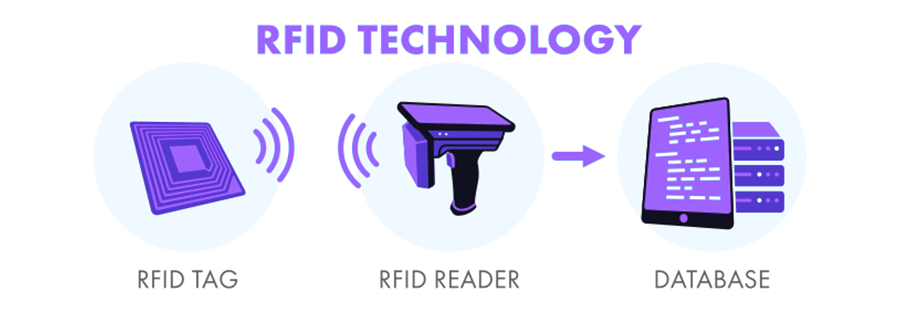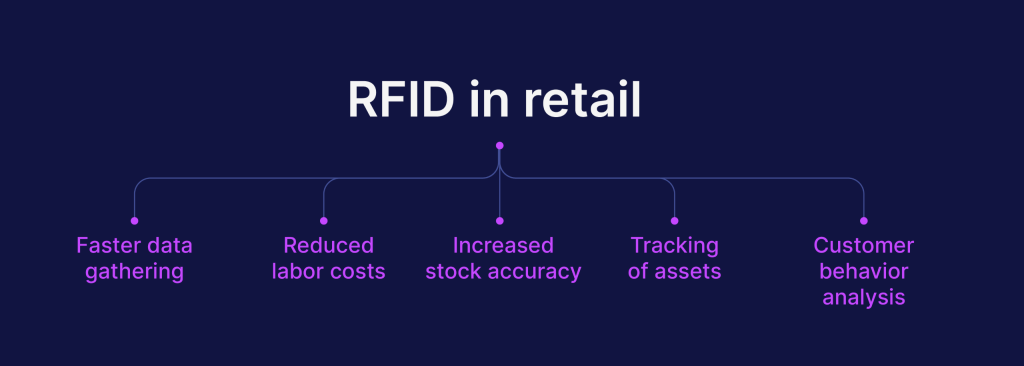How RFID Is Changing Retail For The Better
Retail
How RFID Is Changing Retail For The Better
Managing inventory via barcode scanning is time-consuming and error-prone. But what if there was one technology that could swiftly read inventory data without the need for repetitive tasks as well as provide visibility throughout the supply chain in real-time? Enter RFID.
Emerging technologies that appeared in the past few decades have had a profound impact on the way we interact with our surroundings. Take the smartphone, for example, with its integrated connectivity and portable computing power. How about AI, IoT, and even Wi-Fi? But did you know that RFID is considered among the 25 world-changing technologies?
Over the years, RFID has made its way into many industries and completely redefined processes and operations in its wake. Retail is one of the most prominently influenced industries that has made great innovative use of RFID.
What is RFID and how does it work?
Radio-frequency identification (RFID) is a technology that uses electromagnetic fields to automatically identify and track objects.
In practice, it works by using two components: tags, readers.
The tags carry data and attach to products or packaging to track their location and movement throughout the supply chain.
The reader is a network-connected device that transmits signals via radio waves to activate the tag. Once activated, the tag sends a wave back to the antenna, where it is translated into data and sent to the database.
Unlike barcodes, RFID tags do not require line-of-sight scanning, making them much more adaptable for tracking inventory efficiently, even in complex or crowded spaces.

That sounds like a dream come true for inventory-intensive businesses like retail!
RFID in retail
With supply chain visibility and inventory accuracy becoming more important, RFID has gone from novelty to essential for today’s omnichannel retailers. In an environment where customers expect seamless shopping experiences, whether online, in-store, or both, having a 360-degree real-time view of inventory activities is key to successful retail operations.
According to McKinsey RFID can help retailers unlock up to 5% top-line growth from better inventory control and achieve a 10% to 15% reduction in inventory-related labor hours.
That being said, here’s a look at multiple ways RFID is enabling retailers to achieve their digital transformation goals.
Inventory management
Today, retailers need to stay on top of their stocks, ensuring that the right products are available at the right time in the right quantities. That’s where RFID comes into play and achieves:
- Faster data gathering: RFID tags can be read at long ranges with no overt physical action required to scan a label. So, instead of thoroughly scanning one item at a time, retailers can keep track of their stock by simply bringing the reader within range of the tags. Efficiency is the star of the show here. What used to take hours and days of scanning can now be done in mere minutes. In turn, this opens the door for more frequent inventory checks and updates.
- Reduced labor costs: Labor costs account for a large portion of overall expenses in retail distribution centers (RDCs). Thanks to RFID, tasks like inventory check-in, counting, and shipment verification can be automated in RDCs, eliminating the need for multiple employees to handle them.
- Tracking of returnable assets: Retailers using a returnable fleet, like containers and pallets, have a valuable investment to protect. RFID helps track these assets throughout the entire supply chain, reducing the risk of loss or mismanagement.
Store operation
Running a store is like playing Tetris with inventory; just when you think everything fits perfectly, a new shipment comes in, and you have to start all over. But with RFID, the game gets a whole lot easier. RFID monitors every tagged item so store operators know exactly where everything fits and can adjust accordingly in real-time.
No more stockouts or overstocking, just constant active counts and increased stock accuracy, often up to 98%.
Also, RFID speeds up checkout and even self-checkout processes with faster scanning.
Customer behavior analysis
RFID readers placed around a store capture the signal strength (RSS) from different tags. With this setup, real-time tracking of product movements gives detailed data on how customers interact with different items. For example, if a customer picks up a product, moves it to another section, or returns it to the shelf, these actions are recorded through changes in the RSS data. Machine learning (ML) models can then process the collected data. By extracting time-domain features from the RSS data, ML algorithms can classify different shopping activities, like browsing, picking up items, or moving between sections. Retailers will have access to insights that help them understand customer preferences, optimize product placement, and tailor promotional strategies.

Wrapping up
Advancements being made at the moment, like enhanced antenna and smart tag designs, cloud-based data management, and integrations with other technologies such AI and IoT are pushing the envelope for what RFID can offer to the retail industry. In fact, we applied some of those innovations when optimizing a Fortune 500 leader’s inventory management process, achieving unprecedented speed and accuracy.
As supply chain demands grow and omnichannel retail becomes the norm, RFID’s role is surely set to expand and drive businesses to tap into new opportunities and innovations.

Product Owner




